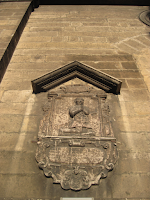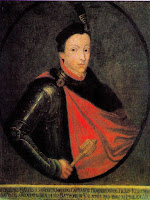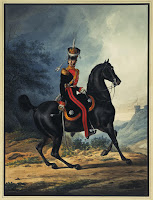Salvete Omnes,
on June 17, but 145 years ago in the Montana Territory a battle was fought between the Plains warriors representing Lakota Sioux and Northern Cheyenne bands on one side against general George Crook commanding the so called Big Horn & Yellowstone expedition consisted of detachments of the US Cavalry and infantry aided by other Plains warriors of the Shoshone and Crow tribal bands. eg wiki page.
This battle is known as the battle of Rosebud or Rosebud Creek, but it
is also known as the battle 'where the girl saved her brother.'
Among the Cheyennes in this battle was Chief Comes in Sight, a brave man
and a good fighter. His sister had followed him out to the battle.
At the beginning of the fight he had charged the soldiers many times, and
when they were fighting the upper group of soldiers, as
he was riding up and down in front of the line, his horse was killed under him.
White Elk was also riding up and down the line, but was going in the opposite
direction from Chief Comes in Sight, and it was just after they had passed
each other that Chief Comes in Sight was dismounted. Suddenly White Elk saw
a person riding down from where the Indians were toward the soldiers,
pass by Chief Comes in Sight, turn the horse and ride up by him, when
Comes in Sight jumped on behind and they rode off.
This was the sister of Chief Comes in Sight, Buffalo Calf Road Woman
(Muts i mi'u na')-
The Cheyennes have always spoken of this battle by this name :
"Where the girl saved her brother —
Kse e' se wo is tan'i we i tat'an e."
Young girl saved his life brother.
[..] It was near where Comes in Sight was unhorsed that the
Shoshoni with a spotted war bonnet was killed.
THE FIGHTING CHEYENNES, p 323-4.
on May 31, 1876 Crook's command consisted of -
Captain John V. Furey - chief quartermaster
Captain W.S. Stanton - the engineer officer for the expedition
dr. Albert Harstuff, assistant surgeon
15 companies of the 2nd and 3rd US Cavalry regiments - commanded by Colonel W. B. Royal
5 companies of the 4th and 9th Us Infantry regiments - Major Chambers commanding
there were 106 US Army wagons driven by teamsters and additional 600 mules led by packers also carrying supplies.
on June 14 some 261 Plains warriors joined the army command, that is this was a contingent of the Shoshone, brought to the camp by Tom Cosgrove as US Army guide to the Shoshone and led by their chief Old Washakie with his 85 warriors, and the 175 Crow warriors under various war-chief -including Plenty Coups, thus assembled to join the Crook's column in march, scout and fight.
There were scouts who communicated between general Crook and the native allied warriors: Frank Gruard, Louis Richaud,, and Big Bat.
The entire Crook's command counted some 1,300 soldiers and warriors.
The native defenders, i.e. about a thousand of the Lakota - Oglala, Minniconjou, Sans Arc, Brule, Hunkpapa etc- and Northern Cheyenne warriors, apart from Wooden Leg, including Two Moon and Little Wolf - under various chiefs and champions. It is said that the Oglala Lakota war leader or blotahunka Crazy Horse was the 'commander' of this native army, but we cannot say that for certain due to the nature of the Plains Indians warfare and their individual desire for glory and honor and martial deeds - the famous coup counting.
Archive world library has a military study(presented in partial fulfillment of the Master of Military Art and Science requirements) of the battle by Richard I. Wiles - it is available for
download or reading upon the site.
On the same site you can borrow many more books on the subject of this conflict and battle, which was a part of the so called Centennial Campaign of 1876.
there are various native accounts of this battle - eg Wooden leg - Cheyenne champion, who might have discovered the invading column, and whose report lead to the first real scrimmage between a Cheyenne party under Little Hawk and the entire encamped column on June 9th.
Anyway, here you can have readily available accounts of the battle made by its participants, both US Army and native.

Famous Lakota warrior champion White Bull thus described, to Stanley Vestal, his attire that day:
'[..]a pair of dark blue woolen leggins decorated with broad stripes of blue and white beads, beaded moccasins, a long red flannel breech-cloth reaching his ankles, tucked under his belt over his regular loin-cloth, a shirt, over the right shoulder he had a thong supporting a small rawhide loop (there were four small leather pouches of different kinds of earth medicine, a buffalo tail and an eagle feather) . around his waist he placed his folded black blanket and belted it with his cartridge belt with a hundred cartridges. He borrowed a war bonnet from his brother in law, Bad Lake, it had a long tail of eagle feathers, while there were no feathers around the head of this bonnet. The bonnet had no protective powers and White Bull took it for its beauty. He was armed with his 17-shot repeating rifle. He selected and saddled his fast horse, on its forelock and tail he tied an eagle feather, while the bridle-bit was adorned with an imitation scalp made from a woman's hair. Only horses which had been used to ride down an enemy could be adorned as such. Then he rode to his uncle Sitting Bull tent where the warriors were gathered.''*
White Bull sang a song -
''Friends, try your best
I do not wish my father to be made ashamed.
Because he is a chief''*
White Bull told a story of his personal encounter with a Shoshone warrior champion - 'he rode a fast bald-faced sorrel with white stockings, his horse tail was tied up in red flannel and a red flannel strip was tied about its neck. The Shoshone warrior had a cartridge belt and a repeating rifle' White Bull killed the Shoshone's horse and counted a coup on the Shoshone warrior whom he lamed in the right leg, but this enemy survived the battle*
Valete
* Stanley Vestal, Warpath: The True Story of the Fighting Sioux Told in a Biography of Chief White Bull - can be borrowed from archive.org library










































